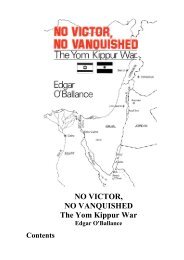israeli fortifications of the october war 1973
israeli fortifications of the october war 1973
israeli fortifications of the october war 1973
You also want an ePaper? Increase the reach of your titles
YUMPU automatically turns print PDFs into web optimized ePapers that Google loves.
Major-General Avraham 'Bren'<br />
Adan was tasked with devising<br />
<strong>the</strong> first plans for what became<br />
known as <strong>the</strong> Bar Lev Line.<br />
His concept for <strong>the</strong> field<br />
<strong>fortifications</strong> along <strong>the</strong> Suez<br />
Canal embraced traditional<br />
defence works as well as<br />
modern electronic monitoring<br />
devices combined with rapid<br />
reaction armoured forces<br />
stationed close to <strong>the</strong><br />
waterway. General Adan<br />
subsequently became <strong>the</strong><br />
commander <strong>of</strong> <strong>the</strong> lAC in 1972.<br />
During <strong>the</strong> October War <strong>of</strong><br />
<strong>1973</strong> he commanded <strong>the</strong><br />
252nd Armored Division in<br />
<strong>the</strong> desperate defence <strong>of</strong> <strong>the</strong><br />
Sinai Peninsula before leading<br />
<strong>the</strong> Israeli counter<strong>of</strong>fensive<br />
across <strong>the</strong> canal.<br />
14<br />
The IDF Chief <strong>of</strong> Staff, Lieutenant-General Haim Bar Lev, headed <strong>the</strong><br />
second school. His reasoning was largely political, since it was deemed<br />
essential that <strong>the</strong> Egyptians be prevented from mounting a limited <strong>of</strong>fensive<br />
and establishing a lodgement on <strong>the</strong> eastern bank <strong>of</strong> <strong>the</strong> Suez Canal<br />
whereupon <strong>the</strong>y would attempt to make it permanent by seeking a UN<br />
Security Council resolution for an immediate ceasefire. It was also essential to<br />
provide increased protection to any troops on <strong>the</strong> front line: while many<br />
families might just accept <strong>the</strong> deaths <strong>of</strong> <strong>the</strong>ir sons and daughters in a <strong>war</strong> when<br />
<strong>the</strong> survival <strong>of</strong> <strong>the</strong> nation was at stake, it was quite ano<strong>the</strong>r matter to have<br />
<strong>the</strong>ir sons blown to pieces by artillery fire whilst playing football in times <strong>of</strong><br />
supposed peace. In his capacity as Chief <strong>of</strong> Staff, General Bar Lev had <strong>the</strong> ear<br />
<strong>of</strong> government. Accordingly his views prevailed and <strong>the</strong> decision was taken to<br />
create a line <strong>of</strong> fixed <strong>fortifications</strong> along <strong>the</strong> Suez Canal and <strong>the</strong> Bitter Lakes<br />
from <strong>the</strong> Mediterranean to <strong>the</strong> Red Sea, a distance <strong>of</strong> some 180km.<br />
The task <strong>of</strong> developing <strong>the</strong> new defence line <strong>of</strong> strongpoints was entrusted<br />
to Major-General Avraham 'Bren' Adan, a highly experienced armour <strong>of</strong>ficer<br />
and <strong>the</strong> creator <strong>of</strong> <strong>the</strong> Sinai Division after <strong>the</strong> Six Day War. General Bar Lev<br />
ordered him to create a team drawn from all branches and services <strong>of</strong> <strong>the</strong><br />
IDF as part <strong>of</strong> an overall reassessment <strong>of</strong> <strong>the</strong> defence plans for <strong>the</strong> Sinai<br />
Peninsula. Improved field <strong>fortifications</strong> were already under consideration<br />
following a study by Major-General Yeshayahu Gavish, GOC Sou<strong>the</strong>rn<br />
Command, that suggested strongpoints opposite those sectors where <strong>the</strong> main<br />
roads in Egypt led to <strong>the</strong> canal, namely at Kantara, Ismailia, <strong>the</strong> Firdan<br />
Bridge, Deversoir and Suez City, as well as commanding <strong>the</strong> roads on <strong>the</strong><br />
eastern bank <strong>of</strong> <strong>the</strong> canal leading to <strong>the</strong> vital Mitla and Gidi passes that were<br />
<strong>the</strong> principal access points back to Israel. The plan was predicated on <strong>the</strong><br />
assumption that <strong>the</strong> IAF would firstly neutralize <strong>the</strong> Egyptian air defence<br />
system thus assuring air superiority before providing close air support to <strong>the</strong><br />
ground troops in <strong>the</strong> role <strong>of</strong> 'flying artillery' given <strong>the</strong> deficiencies <strong>of</strong> <strong>the</strong><br />
army's artillery branch. The operational plan for <strong>the</strong> defence <strong>of</strong> <strong>the</strong> Sinai<br />
Peninsula was codenamed Shovach Yonim or Dovecote.<br />
While <strong>the</strong> Sinai Division comprised three regular<br />
armoured brigades as a standing force, <strong>the</strong>re was usually<br />
a fourth armoured brigade <strong>of</strong> reservists training in <strong>the</strong><br />
Sinai Desert. In times <strong>of</strong> tension, this unit could be called<br />
upon to support <strong>the</strong> regular formation and provide a<br />
credible deterrent against any limited Egyptian incursion<br />
that might result in a politically unacceptable lodgement<br />
on <strong>the</strong> eastern bank <strong>of</strong> <strong>the</strong> Suez Canal. It was also<br />
intended that in times <strong>of</strong> tension <strong>the</strong> troops in <strong>the</strong><br />
strongpoints along <strong>the</strong> canal- usually reservists - would<br />
be replaced by regulars or paratroopers whose level <strong>of</strong><br />
training was considered to be higher.<br />
In <strong>the</strong> classic 'two up and one in reserve' formation,<br />
two <strong>of</strong> <strong>the</strong> armoured brigades would be deployed<br />
for<strong>war</strong>d to protect <strong>the</strong> 180km-Iong canal line with<br />
one brigade in reserve. The for<strong>war</strong>d brigades were<br />
responsible for <strong>the</strong> protection <strong>of</strong> <strong>the</strong> strongpoints in <strong>the</strong>ir<br />
sector. Those strongpoints that were in difficult terrain<br />
or more than 20 minutes distant from <strong>the</strong> main supply<br />
route that ran parallel to <strong>the</strong> canal were to have an<br />
attached tank platoon <strong>of</strong> three tanks for <strong>the</strong>ir immediate<br />
support. This supply route was commonly some 10km from <strong>the</strong> canal and<br />
was known as <strong>the</strong> Artillery Road, since it also allowed artillery units to deploy<br />
rapidly along <strong>the</strong> length <strong>of</strong> <strong>the</strong> front. In each brigade sector, two armoured<br />
battalions, each <strong>of</strong> three tank companies, were stationed close to <strong>the</strong> road<br />
so <strong>the</strong>y too could deploy rapidly to block any crossing attempts. These<br />
companies were expected to reach <strong>the</strong> canal or any threatened strongpoint in<br />
under 30 minutes. The third armoured battalion was held in reserve close to<br />
<strong>the</strong> Lateral Road that also ran parallel to <strong>the</strong> canal but at a distance <strong>of</strong> some<br />
30km. This unit was expected to reach <strong>the</strong> canal within two hours <strong>of</strong> an alert<br />
order. The plan called for <strong>the</strong> fourth or reserve armoured brigade, if present<br />
in <strong>the</strong> Sinai, to concentrate at Tassa on <strong>the</strong> Central Road so that it would be<br />
able to support any sector under threat.<br />
Never<strong>the</strong>less, Dovecote was predicated on <strong>the</strong> assumption that prior to<br />
<strong>the</strong> outbreak <strong>of</strong> general <strong>war</strong>fare <strong>the</strong>re would be sufficient <strong>war</strong>ning time to<br />
mobilize <strong>the</strong> reserves. However, <strong>the</strong> new borders created by <strong>the</strong> Six Day War<br />
had changed <strong>the</strong> dynamics <strong>of</strong> <strong>the</strong> IDF's <strong>of</strong>fensive doctrine. The strategic depth<br />
now afforded by <strong>the</strong> Sinai Desert, so longed for by <strong>the</strong> IDF high command<br />
since <strong>the</strong> War <strong>of</strong> Independence, allowed <strong>the</strong>m <strong>the</strong> option to ei<strong>the</strong>r launch a<br />
pre-emptive strike if <strong>war</strong> seemed imminent - although with all <strong>the</strong> serious<br />
international political disadvantages that would accrue - or to allow <strong>the</strong><br />
enemy <strong>the</strong> first strike and <strong>the</strong>reafter use <strong>the</strong> expanse <strong>of</strong> <strong>the</strong> Sinai Desert to<br />
employ <strong>the</strong> Israeli predominance in manoeuvre <strong>war</strong>fare to <strong>the</strong> full: a choice<br />
denied to <strong>the</strong>m prior to June 1967 when <strong>the</strong> enemy was lying so close to<br />
Israeli population centres. With <strong>the</strong> Sinai in Israeli possession, <strong>the</strong> <strong>war</strong>ning<br />
time against enemy aircraft attack increased from four minutes to 16, a<br />
crucial difference <strong>of</strong> a fur<strong>the</strong>r 240km <strong>of</strong> flying time. But by creating static<br />
<strong>fortifications</strong> along <strong>the</strong> Suez Canal, <strong>the</strong> bulk <strong>of</strong> <strong>the</strong> Egyptian Army<br />
permanently stationed on <strong>the</strong> western bank was just 150m from <strong>the</strong> Israeli<br />
front-line troops. This allowed <strong>the</strong> Egyptians to change from a defensive to<br />
<strong>of</strong>fensive posture in <strong>the</strong> shortest possible time and thus any <strong>war</strong>ning time was<br />
potentially negated to a dangerous and unacceptable degree. There is a<br />
considerable difference between 240km and 150m. Accordingly, more troops<br />
were needed close to <strong>the</strong> canal to provide support to any line <strong>of</strong> strongpoints.<br />
With its parachute brake<br />
deployed, an F-4E <strong>of</strong> IAF No.<br />
201 Squadron 'Ha'ahat' lands<br />
after a mission during <strong>the</strong> War<br />
<strong>of</strong> Attrition. The first four Israeli<br />
McDonnell Douglas F-4E<br />
Phantom II fighter-bombers<br />
landed at Hazor AFB on S<br />
September 1969 and entered<br />
service with IAF No. 201<br />
Squadron 'Ha'ahat' or<br />
'The One'. The Kurnass or<br />
Sledgehammer, as <strong>the</strong><br />
Phantom was known in Israeli<br />
service, conducted its first<br />
operational sortie just one<br />
month later on 5 October and<br />
its first attack mission during<br />
Operation Pirkha on<br />
22 October, destroying an<br />
SA-2 site near Abu Suweir.<br />
Thereafter, <strong>the</strong> Kurnass<br />
multi-role combat aircraft<br />
gave <strong>the</strong> IAF a strategic strike<br />
capability that was employed<br />
extensively during <strong>the</strong> War <strong>of</strong><br />
Attrition to engage targets<br />
deep inside Egypt as well as in<br />
<strong>the</strong> Suez Canal Zone. Eight<br />
Kurnass fighter-bombers were<br />
lost during <strong>the</strong> War <strong>of</strong> Attrition<br />
with six to AAA and SAMs and<br />
one to a Syrian MiG-21 while<br />
<strong>the</strong> o<strong>the</strong>r was destroyed in<br />
an operational accident in<br />
March 1970.<br />
15




